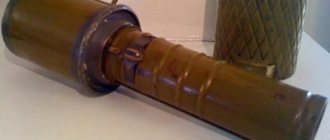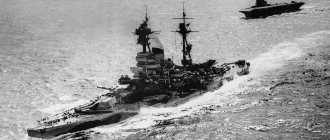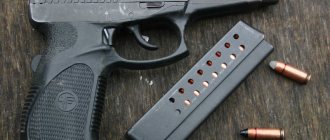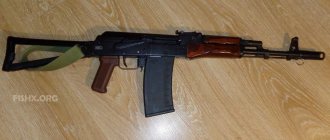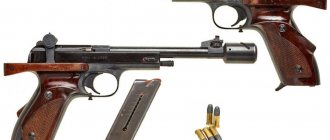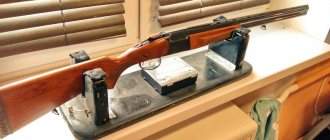The image of a German soldier is inextricably linked with certain elements of uniform and weapons. Among them are a feldgrau helmet with a distinctive shape, an MP38/40 submachine gun and M24 grenades with a long wooden handle. Not a single film about the Great Patriotic War and not a single historical reconstruction of the events of those years can do without these attributes.
Because of its similarity to the Russian masher, which we all use to mash boiled potatoes, it was nicknamed that. It should be noted that Russian soldiers used such captured grenades in battles, as well as MP-40 and Schmeiser assault rifles, but that’s a slightly different story.
Design
The grenade consists of a metal body, inside of which there is an explosive based on ammonium nitrate (dynamon, ammonal) as well as pyroxylin mixtures weighing 160-180 g, a detonator capsule, and a hollow, closed from below with a screw-on lid of a wooden handle with an ignition mechanism housed in it.
In addition to ammonal, other explosives were also used to equip this grenade, most often granulated TNT. The grater type ignition mechanism consisted of a remote tube with a primer, a cup with a grater composition, a cup cup, a wire grater with a lead (or porcelain) ball and a silk cord with a porcelain ring.
The body of the grenade was primed with red paint and painted field gray (German: Feldgrau) or dark green and could (optionally) have a hook for carrying the grenade on a belt. In this form, the grenade was used as an offensive one and had a radius of destruction by fragments of about 10-15 m.
To use the grenade as a defensive one, a jacket made of steel or metal-ceramic composition with notches was used, which was attached to the body with wire. The radius of destruction of a grenade equipped with a fragmentation jacket increased to 30 m, and the scattering range of individual fragments could reach 100 m.
Operating principle
For the M-24, German designers provided a grating type of ignition mechanism. It consisted of a grating device and a pull cord, the end of which was equipped with a special white porcelain or lead ring. The upper end of the cord was attached to the grater device. It had the shape of a tube, inside of which the grating composition was located; the designers passed a wire spiral (grater) through it. The location for the powder moderator was the central channel of the bushing, with which the tube was equipped by screwing.
Without a blasting cap, the M-24 was considered absolutely safe. To operate a grenade, its sleeve must contain this igniter. One of the features of the M-24 can be considered the presence of a gray-white smoke screen, which could last up to three minutes, thus covering the infantry from the eyes of the enemy.
M24 grenade design
According to its purpose, Stielhandgranate 24 is of the offensive type with a remote fuse. The structure includes the following elements:
- A thin-walled (with a wall thickness of no more than 1.0 mm) metal casing in which an explosive charge and a combat fuse are located. Compounds based on ammonium nitrate or pyroxylin (granulated TNT) were used as a charge. The weight of the charge varied between 160...180 grams. The type of substance was indicated in the form of a code on the body (“Mo” - monkite, “Do” - donarite or “Grf.88” - picric acid).
- An igniter or grating-type remote tube, consisting of several elements. In the upper part there was a hollow aluminum coupling with an external thread, with the help of which the fuse was fixed in the body of the M24 grenade. A Sprengkapsel No. 8 beam ignition detonator was installed at the upper end of the coupling, and a steel tube with a pyrotechnic flame retardant was screwed into the other side. The use of soft aluminum made it possible to tightly compress the detonator. A lead cap was screwed onto the other end of the moderator, inside of which the ignition charge was located. A metal ignition rod with a rough surface, equipped with a metal ring for installing the cord, was installed in the cap.
- Wooden handle, quite long. Inside, the handle is hollow and contains a fuse pull cord with a porcelain or lead roller at the end, which serves to more securely grip the cord with your hand. At the bottom of the handle there is a metal ring with a thread onto which a safety cap is screwed. At the upper end of the handle there is a threaded tip, which is used to connect the handle and the body.
To use the M24 grenade, it was necessary to unscrew the cap on the handle, which served as a safety device. The lid was made of a thin steel sheet (thickness about 0.3 mm) and painted in the color of the head part.
There is a spring installed in the cover that presses the roller and prevents it from dangling. A cord with a roller fell out of the handle, which had to be pulled sharply. At the same time, the rod began to move, due to the friction force, the igniter was ignited, and then the moderator charge began to burn.
After this, it was necessary to make a throw, since the explosion occurred after 4.5...5 seconds (in fact, up to 8 seconds). The destructive force of fragments of the standard version of the M24 was up to 15 meters. If the grenade did not go off within 30 seconds, it was considered not dangerous. Since the tip of the striker was retracted from the primer by a spring.
When using a grenade of the Stielhandgranate 43 type, it was necessary to unscrew the safety cap on the top.
The cap was connected to the ignition cord for ease of use. Further use did not differ from the M24 model.
To enhance the effect of the explosion, M24 grenades could be collected in bundles. When used alone, an additional steel or metal-ceramic defensive jacket with a notch on ready-made submunitions was often used, which was put on the main body and fixed with metal wire.
The use of a shirt made it possible to increase the radius of scattering of fragments to 100 m, and they retained destructive power at a distance of up to 30 meters.
For carrying and storage, a reusable metal closure for 15 places, equipped with a carrying handle, was used.
The grenades were transported without fuses or detonators. Each cap could accommodate 10 regular M24s, and five M24 grenades with an additional jacket. At the end of the war, wooden rectangular boxes with rope handles on the sides began to be used for storage.
Sprengkapsel No. 8 detonators were stored capped in a separate wooden case equipped with a sliding lid. The pencil case was packed in a cardboard shell.
YouTube3:26
Brennzunder 24 igniters were in a metal box, taped with a special tape that protected the devices from moisture. Immediately before use, igniters and detonators were installed in the handles. On the head of the grenade there was a warning painted in white paint: “place the detonator before use.”
Operating principle and design of the grenade
Stielhandgranate M24 is a steel cylinder with a diameter of 70 millimeters, “attached” to a hollow wooden handle screwed to its underside. The thickness of the body walls was about a millimeter. The total length of the assembled grenade is more than 35 centimeters.
The main purpose of the wooden handle is to increase the throwing distance. A well-trained soldier could throw a “mallet” 65 meters, and sometimes further. In the conditions of the positional war of 1914-1918, this quality was considered very valuable.
A grating fuse (remote tube) was used to explode the grenade. Its upper part, with a detonator at the end, was inserted into the lower part of the body. The lower half was placed inside the handle and ended with a metal ring. Attached to this was a ignition cord running the entire length of the wooden handle and ending in a small porcelain ball.
Schematic diagram of the Stielhandgranate M24 grenade
When using a loaded grenade, the following happened:
- The safety cap at the bottom of the wooden handle was unscrewed. A porcelain ball fell out from inside and hung on the ignition cord;
- A sharp jerk of the ignition cord was performed;
- The ignition rod connected to the cord intensively rubbed against the walls of the remote tube and heated up;
- Due to the increase in temperature, the igniter ignited, transferring the fire to the retardant;
- The combustion of the moderator led to the explosion of the detonator, after which the main charge detonated.
In order to enhance the fragmentation effect of the grenade, a cast iron “shirt” could be installed on it. The RGD-33 was equipped with a similar device, and some sources claim that the Germans “borrowed” this idea from Soviet designers. According to other sources, the use of a special “shirt” was envisaged already in 1924. In any case, the Wehrmacht grenadiers did not always have this simple device at their disposal - and then, for example, barbed wire could be used to “wrap” the body of a grenade.
History of creation
The design of the German M24 grenade differs little from a similar product that appeared at the initial stage of the First World War. The Stielhandgranate 15 grenade appeared in service with infantry grenadier units at the beginning of 1916 and was widely used during the battles of Verdun.
A distinctive feature of the first model was a handle with a ball-shaped tip from which a cord hung. As a safety feature, the cord was glued with adhesive tape to the side surface and filled with paraffin, which simultaneously provided protection from moisture. There were variants of the Stielhandgranate 15 with a lever driven igniter (Poppenbergsches scheme).
A later version of the Stielhandgranate 16 was equipped with a simplified handle, at the end of which there was a metal safety cap. To equip grenades, a mixture consisting of three components was used:
- 84% ammonium nitrate;
- 12% TNT;
- 4% wood flour.
The grenades were equipped with a spring clip for carrying on a belt or behind the top of a boot and a “long” fuse that burned for 6.5 seconds. At the very end of the war, simplified ersatz versions were produced with cardboard handles nailed to the adapter ring and a factory-installed fuse.
The first modernization occurred in the early 20s and consisted of the introduction of a “short” fuse (burning time no more than 5 seconds), a reduced warhead and a new carrying mount (in the form of a loop).
A more powerful substance was used for equipment, which slightly improved combat characteristics. The new version became known as the Stielhandgranate 24 mit Brennzunder 24 (type 24 hand grenade with a powder spacer tube, model 1924) or Stielhgr 24 for short.
In addition, there was a simplified version of Stielhandgranate 43, which began to be produced in 1943.
The difference between this grenade was the use of a Bz.E.39 fuse (from the M39 model), screwed into the upper part of the head section. This design made it possible to use a grenade with the handle removed.
Three types of fuses were used for equipment, differing in the color of the caps and burning time:
- red (for 1 sec);
- blue (for 4.5 sec);
- yellow (for 7.5 seconds).
Performance characteristics
- The Stielhandgranate was in service from 1916 to 1945.
- The M-24 is a type of anti-personnel hand grenade.
- Country of origin: Germany.
- Dimensions of the M-24 grenade: 356 mm (length) x 75 mm (body) x 6 cm (diameter).
- Grenade weight: 500 grams.
- The mass of the explosive was 160 grams.
- The length of the M-24 grenade handle is 285 mm.
- The M-24 was used in two world wars and during the Vietnam War.
- The product was intended for throwing at a distance of 30 to 40 meters.
- The M-24 retarder is designed for 5 seconds.
“Bath Leaf”, No. 74 ST
Most anti-tank grenades operated on the principle of an instantaneous explosion. In fact, the delay in firing a salvo could reach a second. Naturally, during this time the shell managed to bounce off the tank’s armor at a decent distance and did not cause much damage to it. But what if the shell stuck to the tank? For this purpose, in 1940, Britain developed the sticky anti-tank grenade No. 74 ST, better known as the “Bath Leaf”.
#74 ST| Photo: Informator.
The design of the weapon was extremely simple: nitroglycerin was poured into a glass vessel, and the top of the grenade was covered with a sticky mass. To prevent the weapon from sticking to the soldiers, it was placed in a special metal case. However, from the very first days, the effectiveness of the “Bath Leaf” was massively criticized by the British infantry. In a combat situation, it was extremely difficult to quickly remove a grenade from its case, and in order for the projectile to firmly adhere to the tank, its surface must be dry and clean, which, again, is practically impossible in combat conditions. Not to mention the fact that nitroglycerin itself is an extremely dangerous substance that could “explode” under sudden temperature changes and strong shaking.
Use Cases
In the vast majority of cases, “mallets” were used against enemy personnel - both offensively and defensively. Nevertheless, there were other options for combat use of the grenade. In particular, bundles of several M24s were made to destroy field fortifications and as an anti-tank weapon. The heaviest of them were made up of seven grenades connected in a “six around one” pattern. The handle was attached only to the central grenade, this was enough for simultaneous detonation. The force of the general explosion made it possible to break through armor 15-20 mm thick.
A number of sources also note episodes of destruction of heavy KV-2 tanks with the help of “mallets” thrown directly into the barrel of their 152-mm gun. There is nothing incredible about this, however, as is known, the total number of KV-2s was insignificant, and the cases of their appearance on the battlefield were almost isolated.
Another option for using Stielhandgranate was mining the area. Since in this case an instant detonation was required, the grenades were equipped with DZ-35 fuses, which were triggered when pressed, instead of standard fuses.
German soldier with a bunch of M24 grenades
Stielhandgranaten 24
The Stielhandgranaten 24 is a modified WWI Stielhandgranaten 1916. In the early 20s, the Stielhandgranaten 16 was slightly modified, its weight and size were reduced, and the brackets for attaching to the belt were removed from the grenade body. The modified version received the official name “Stielhandgranaten 24”
German Stielhandgranaten with bracket, First World War
The long handle and placement of the grenade's center of gravity allows the average soldier to throw a grenade 30-40 meters. Physically strong fighters could throw a grenade 60-65 meters.
The scattering of fragments is about 15-20 meters in the offensive version and up to 30 meters in the defensive version. To use the grenade as a defensive one, a fragmentation shirt made of metal, with or without notches, was put on the body.
fragmentation jackets for M24 grenade
To significantly increase the charge power, for example when fighting tanks, grenade bundles were used.
Filling:
The M24 grenade was loaded with 160-180 grams of TNT, amonnal, monarchite, donarite or melenite. In Soviet grenades the mass of explosives was less (110 grams in the RG-42 and 60 in the F-1).
The main disadvantage of this grenade was the sensitivity of the grating fuse to dampness, which led to frequent failures. In addition, if the ignition cord was not pulled out sharply enough, the grating composition did not ignite and the grenade did not work.
After pulling out the ignition cord, the grenade had to be thrown, because the moderator began to burn and after 4.5-5 seconds an explosion followed (after pulling out the pins, Soviet grenades could be held in the hand for an indefinitely long time, choosing the moment and target for the throw, and if the decision to throw was cancelled, the pin could be put back in place).
Advantages and disadvantages
Stielhandgranate M24 has several undoubted advantages:
- The simplicity of the device and the associated manufacturability, which made it possible to produce tens of millions of grenades;
- Ease of throwing. The long handle makes it possible to throw a grenade 40-50 meters without much effort. In addition, good accuracy is ensured;
- Easy and at the same time safe handling of the grenade.
At the same time, it should be noted that in general the “mallet” was already an obsolete weapon by the beginning of World War II. Its main disadvantage was its insufficiently high reliability. There were two reasons for this: firstly, explosives based on ammonium nitrate do not survive long-term storage, gradually losing the ability to detonate. Secondly, the insufficiently high tightness of the structure led to dampness of the igniters and moderators. As a result, sometimes the fuse did not fire, and sometimes the main charge “did not want” to detonate.
M24 grenade carrying box
In addition, the very use of a grating ignition mechanism can already be considered a disadvantage. Because of this feature, after pulling out the ignition cord, it was necessary to immediately throw the “mallet”, which was not always convenient. More modern fuses made it possible to hold a grenade with the pin pulled out in your hand, waiting for the optimal moment to throw it.
“Turtle” Diskushandgranate M.1915
Everyone has heard about the legendary German fragmentation grenade Stielhandgranate, which faithfully survived two world wars. However, the German “mallet”, like all similar grenades, had one significant drawback - a long response interval (about 8 seconds). During this time, the enemy could intercept the grenade and throw it back. To solve this problem, instant-action grenades began to be developed. A striking example of such explosive devices is the Diskushandgranate M.1915 grenade, created in Germany in 1915.
Diskushandgranate M.1915 disassembled| Photo: Wikipedia.
The projectile was shaped like a disk with six spikes, which is why German soldiers nicknamed it the “turtle.” The explosion occurred immediately after the grenade's spikes touched the obstacle. It would seem to be an extremely effective weapon, but in practice everything was much worse. Firstly, the grenade was extremely inconvenient to throw, and secondly, it might not work if it hit soft ground or fell flat. Often the German soldiers themselves were blown up on the “turtles,” so the “innovative” development had to be abandoned immediately.
Comparison with other World War II grenades
The main opponent of the Wehrmacht in World War II was the Red Army. From 1941 to 1945, it was armed with several different types of grenades. The closest ones to Stielhandgranate are RG-14/30 and RGD-33. Both of them had handles that were intended to increase throwing distance.
RG-14/30 was a modernized version of the Rdultovsky grenade. Weighing 700 grams, it contained 300 grams of explosives, that is, almost twice as much as the “mallet”. Using the RG-14/30 was not particularly convenient due to its excessive mass and difficulty in handling - 11 different manipulations had to be performed before throwing - and this was in the midst of battle.
RGD-33 by June 22, 1941 became the most popular Soviet grenade. Moreover, it was, in essence, another modification of the same Rdultovsky grenade. True, the weight was reduced to 500 grams (which almost coincides with the mass of the “beater”).
RGD-33 - the most popular grenade of the Red Army on the eve of the war
Simplification of the design made it possible to reduce the number of “preparatory” operations before use. However, this grenade can hardly be called successful. The biggest question is the initiation of the fuse - for this it was necessary to perform a sharp swing before throwing, which is even less reliable than pulling the cord from the Stielhandgranate.
In 1942, the RG-42 offensive grenade was adopted by the Red Army. In its combat qualities it was superior to the “mallet” - mainly due to the convenient, practical and reliable fuse of the UZRG.
The Soviet F-1 defensive grenade, which is still used today, was considered the most popular among Red Army soldiers and especially among intelligence officers. It was created on the basis of the French F.1, which appeared during the First World War. In 1942, the F-1 received the same UZRG fuse as the RG-42. It is noteworthy that the mass of explosives placed in the F-1 body is only 60 grams, almost three times less than that of the Stielhandgranate, but at the same time the effectiveness of the Soviet grenade is much higher - the defeat is carried out not by a blast wave, but by cast iron fragments.
Model of an American World War II hand grenade Mk 2The allies in the anti-Hitler coalition used mainly English Mills grenades and American Mk.2 grenades, very similar to the F-1, in World War II. In general, they were also superior to the mallet in terms of reliability and ease of use. In addition, their use as “gun” (“rifle”) grenades was allowed. The only advantage of the M24 was still its increased throwing range.
Author of the article:
Fedorov Dmitry
Modifications
The metal clip for carrying a grenade on a belt is characteristic of the anti-personnel fragmentation grenades of the First World War Stielhandgranate 15 (in the background, with a solid wood turned handle) and Stielhandgranate 16 (on the back of the handle there is a characteristically shaped screw cap)
At the end of the First World War, during a period of acute shortage of raw materials, equipment (in particular, metal, wood and lathes for making handles), as well as skilled labor, simplified non-separable grenades with a factory-installed primer were produced in Germany and Austria-Hungary -detonator:
- option with reinforced handle fastening (fastening is improved by lengthening the body coupling and additional fixation of the handle with nails) and replacing the metal screw cap with a cardboard cap secured with waxed paper tape;
- option with a handle made of cardboard twisted into a tube (made by winding a cardboard spiral onto a blank and then gluing it), with an extended coupling, fastened to the body with six nails and with a cardboard cap.
There are also known semi-handicraft grenades with handles, in which, instead of a rubbing mechanism with a cord, a spring mechanism was used for impact ignition of the primer.
Other uses
The body of the popular Stielhandgranate 24 grenade was also used in the manufacture of anti-personnel mines Stielhandgranate 24/DZ 35
D.Z
Sprengkapsel No8
detonator capsule using a Spannmutter adapter (due to the different thread sizes). 35 .
When such a mine exploded, most of the hull fragments (93-97%) went into the ground, and the main damage was inflicted by an upward shock wave.
Since the grenade was equipped mainly with surrogates, it did not have a powerful high-explosive or blasting effect. To inflict significant damage to the heavy armored vehicles of the Red Army, the German infantry practiced a risky technique: a bunch of 3-5 grenades were slipped under the rear niche of the tank turret using a waist belt and detonated; the distance of the fuse was enough for the grenadier to jump from a moving vehicle and hide from the explosion. If successful, the turret was torn off the shoulder strap or, at a minimum, jammed. To destroy a KV-2 breakthrough tank, it was a very effective means to throw a grenade into the barrel of the 152-mm howitzer with which it was armed. Even if there was no projectile in the barrel at the time of the explosion, the barrel itself lost its integrity and exploded with the next shot. (A.B. Shirokorad, “Tank War on the Eastern Front”).
Characteristics of the German M-24 Stielhandgranate hand grenade model
| Explosive | absent |
| MMG grenade detonator | absent |
| Ring checks | No |
| Threaded insert | No |
| Case notches | No |
| Manufacturer | Izhevsk (RF) |
| MMG grenade weight, grams | 200-500 |
| MMG grenade body | metal/wood |
| Product weight | 0.5 kg |
| certificate |
Model of the German hand grenade M-24 Stielhandgranate Mallet buy in the Popadiv10 online store. Model of a German hand grenade M-24 Stielhandgranate Mallet at a low price of 1190 RUR. You can pay for your order by mail upon receipt in any part of the Russian Federation. Before placing an order, be sure to check the price and contents of the product by phone (during business hours) or by e-mail and feedback system (at any time convenient for you).
The information on the product “Model of a German hand grenade M-24 Stielhandgranate Mallet” is for informational purposes only and is not a public offer as defined by the provisions of Article 437 of the Civil Code of the Russian Federation; characteristics, appearance, color and equipment may be changed by the manufacturer without notice.
Send books!
“I just asked the foreman: have you sent any books? “Yes,” he answered. Not only the parcel, but also the letter could not be opened. The guys were covered with such mortar fire that they could not raise their heads from the crack. And only in the evening, having gone down into a deep ravine, they made a shelter for blackout and read the letter. How much joy and delight! All the soldiers asked me to write to the staff of your library the next day...”
This letter of gratitude, written by the hand of soldier Mikhail Melnikov, stitched with shrapnel, and sent from a military hospital, is one of the many evidences of the invaluable importance of books during the fiery years of the Great Patriotic War. Some went through the entire war with a volume of their favorite poems, others with Nikolai Ostrovsky’s novel “How the Steel Was Tempered,” and for others an astronomy textbook served as a front-line comrade.
Books were picked up in the libraries of bombed cities, found in destroyed residential buildings, received by front-line mail from division headquarters, taken to the front from short-term vacations... “I missed books terribly. In one village we found “Eugene Onegin”, so we read it to the core. Every free minute we read it out loud with rapture,” Ariadna Dobromyslova, a medical instructor of the 308th Infantry Division, said in a letter to her family.
The poems copied by hand were hidden in the tops of their boots - and they bravely went into battle. In between battles, they organized collective readings for fellow soldiers
They also used books to exchange military information - writing down the information collected by the underground between the lines and transporting it behind the front line.
Legends about book miracles were passed on from mouth to mouth. Alexei Tolstoy’s novel “Peter the Great” saved the life of soldier Georgy Leonov: a bullet got stuck in a thick volume hidden under his tunic. Senior Lieutenant Pyotr Mishin survived the battle thanks to a collection of Pushkin’s poems: after breaking through two hundred pages, a shell fragment stopped right... in front of the poem “Talisman”!
The names of writers were assigned to military units and military equipment: the detachment named after Gorky, named after Lermontov; tank “Vladimir Mayakovsky”, “plane Dmitry Furmanov”... Pushkin was included in the crew of one of the patrol ships of the Northern Fleet. In one of the divisions, Maxim Gorky served as an “honorary Red Army soldier”; his name was called out every day at verification.
The commander of one of the units of the Ukrainian Front presented the poetry collection “Kobzar” by Taras Shevchenko as a rolling prize to distinguished soldiers. The young writer Ivan Dmitrochenko, appointed commander of one of the guns on the Leningrad Front, punished his soldiers: “For Ivan Sergeevich Turgenev - fire! For "War and Peace" - Fire! For great Russian literature - fire!..”
The archives contain numerous letters of request from the front lines to send books. “There comes a time during battles when you want to read at least a little... If possible, send me something from fiction books. Old, shabby, better if without binding, so that they can be stored in a duffel bag or field bag,” Red Army soldier A.P. Stroinin wrote to librarians.
Doublet copies from libraries were sent to the front. Regular collections of books from the civilian population were carried out. They made homemade books from newspaper clippings. In the first year of the war, poems were even printed on bags of food concentrates.
Book-military doctor
The role of books in hospitals is invaluable. Readings aloud and literary evenings were organized for the wounded. The greatest demand was for entertaining literature: adventures, detective stories, fairy tales, feuilletons - anything that could distract from pain and cheer up. And the most read novels were “War and Peace” by Tolstoy, “The Gadfly” by Voynich, “How the Steel Was Tempered” by Ostrovsky.
Bibliotherapeutic subjects are presented in front-line drawings by People's Artist of the USSR Nikolai Zhukov. A talented illustrator and graphic artist, he met Victory in Vienna with the rank of captain, made sketches at the Nuremberg trials - in 40 days he created about 400 images of all its participants.
The main Russian classic who heroically fought alongside our soldiers was Alexander Sergeevich Pushkin. This is evidenced by unimagined front-line stories and literary works about the war. Memorial certificates and museum exhibits remind us of this.
The story of a Pushkin collection sent to the front by a young Muscovite with the inscription: “From the girls of the plant named after. Stalin as a gift. Read, dear comrades, and love Pushkin’s poems. This is my favorite poet, but I decided to send this book - you need it more, remember us. We are making weapons for you. With warm regards. Vera Goncharova."
In the summer of 1942, in the destroyed library of the city of Boguchar, Sergeant Stepan Nikolenko discovered a surviving volume of Pushkin’s poems and did not part with it until Warsaw, until a fascist plane dived onto the convoy. As soon as he woke up in the hospital, Stepan first inquired about the fate of the treasured book.
An echo of this poignant story is in the famous poem by Vera Inber: “... In the hospital for a long time he lay, without strength, as if dead, on a pillow. And the first thing he asked, Having regained consciousness: “And Pushkin?” And the friend’s voice, hastening, answered Him: “Pushkin is alive.”
In the harsh winter of the same year, Sergeant Boris Poletaev ended up in the death camp near Siauliai with a one-volume book of Pushkin’s lyrics. Reading aloud helped me survive in inhuman conditions. As one of the prisoners said, “Pushkin is with us, in the sixth barracks, like a regimental commissar: he lifts the spirit of people.” Now this priceless book - completely dilapidated and missing its cover - is stored in the gift cabinet of the State Museum of Fine Arts. A. S. Pushkin.
And the Moscow Defense Museum is rightfully proud of the “Group portrait of the descendants of A. S. Pushkin - participants in the Great Patriotic War” by Vladimir Pereyaslavets. On one canvas, an aircraft mechanic, a militia fighter, a Baltic Fleet sailor, the commander of a communications department, a combat crew commander of an anti-aircraft regiment and a partisan of a special forces detachment came together to read the poems of their great great-grandfather and great-great-grandfather.
The artist, who served as a fighter pilot during the war, created a fictitious plot: those depicted were never assembled in such a composition. Their meeting became a symbol of national unity under the auspices of the great national Literature. The same idea is in a wonderful poem by front-line poet Sergei Smirnov: “...And Pushkin, our great Russian genius, Went with us into battle for the honor of his land: We carried all his collected works Not in duffel bags, but in memory!”
May 5, 1945 went down in History with an excerpt from Pushkin’s “The Snowstorm,” which was read by the actress of the Moscow Art Theater Nina Mikhailovskaya near the destroyed Reichstag.
***
… “When I arrived at my company, I learned that some of the books were lost with my comrades. Kogan was killed behind Goncharov's book by a shell. The books of Gorky and Ostrovsky were blown apart by a direct hit from a mine, leaving no traces of them, soldier Mikhail Melnikov, who returned to duty, continued to tell librarians in a letter. “So in the battles for the Carpathians we fought together with books, and those who were destined to die died with them.”
Application procedure
To use the Stielhandgranate 16 grenade, you had to unscrew the cap at the bottom of the handle and vigorously pull the cord with the porcelain ball that fell out.
Since the detonator caps were stored separately when delivering grenades to the troops (in boxes of 15 each), to prepare the grenade for battle it was necessary to unscrew the handle from the body, insert the detonator cap into it and screw the handle back on.
To use a grenade, you had to unscrew the cap at the bottom of the handle, vigorously pull the cord with a porcelain ring that fell out, and immediately throw the grenade at the target.
When the cord was pulled out, the wire grater connected to it, curled into a spiral, straightened through the hole in the cup, creating friction and igniting the grater composition. The flame of the grinding composition ignited the powder pulp of the moderator, which burned for about 4.5-5 seconds. The fire from the powder pulp was transferred to the detonator cap (fuse), the explosion of which caused the detonation of the explosive charge of the grenade.
Weak sides
Despite a number of advantages, the Stielhandgranate fragmentation grenade was not without some disadvantages:
- The explosive used to fill the casings was very unstable to moisture. This is explained by the fact that in wartime a surrogate was predominantly used as an explosive, the basis for which was ammonium nitrate. In this regard, storing the M-24 became significantly more complicated: the grenades had to be in disassembled form (with the detonator caps removed and placed separately). At the same time, in warehouses it was necessary to carefully monitor that moisture did not affect the Stielhandgranate body itself. The negative impact of moisture also affected the grating fuse. Very often it fell into disrepair. When the cord was pulled out, ignition did not occur and the grenade did not go off.
- The hand-held fragmentation M-24 could become completely unusable as a result of long-term storage. This was caused by the caking properties of explosives.
- The retarder was designed to last for five seconds. Thus, the German soldier who pulled the fuse had to meet this time and throw the M-24. The retarder could also operate either half a second earlier or four seconds later.
Small arms, ammunition, devices and accessories of the 19th-21st centuries
The site is a private collection of materials on the topic “firearms and ammunition” and is an amateur information and educational weapons portal. All information was obtained from open sources. The administration does not claim authorship of the materials used - all rights belong to their owners. The administration is not responsible for the use of information, facts or opinions posted on the site.
- Account Registration
- Weapon
- home
- Rules
When was the M-24 created?
The grenade began to be developed by German weapons engineers during the First World War. During this period, all warring parties made attempts to create hand-held offensive weapons effective in close combat, craters and trenches. The Russian army has already used the RG-14 hand grenade, created by V.I. Rdutlovsky. The British used the 1915 system anti-personnel grenade, which would later become known as the “limonka”, or F-1.
Before making the M-24 grenade, German weapons designers carefully studied the Russian and German versions. It was decided to equip German infantrymen with similar offensive weapons. The Reichswehr assault battalions received the Stielhandgranate already in 1916.
The task of the new grenade was to defeat enemy personnel using fragments and the shock wave created during the explosion. The target could also be armored enemy barriers, fortifications and firing points. In such cases, German soldiers used a bunch of several grenades. Thus, the Stielhandgranate was intended solely for an offensive task. In 1917, the grenade became mandatory equipment for German infantrymen.
The Great Patriotic War
During World War I, the Stielhandgranate-24, or M-24 hand grenade, was considered one of the most modern. But by the beginning of the Great Patriotic War, its design needed modernization. Despite all the attempts made by German gunsmiths to improve the M-24, the grenade remained at the 1924 level. But nevertheless, due to the lack of the enemy’s best destructive weapon, the serial production of Stielhandgranate-24 was not stopped. Over the course of World War II, over 75 million M-24 units were produced. The grenade was in service with the German army until the very end of the war.
Combat use and proliferation
The first version of the Handgranate 17 proved popular among the infantry units of the Kaiser's Germany and was used against infantry and to destroy barbed wire barriers.
There have been isolated cases of grenades being used against tanks.
During World War II and the Great Patriotic War, the M24 was the main type of such weapons. In addition to single grenades, bundles were used, which were assembled on wire and spring holders. The bundle could include grenades of the M24 and M39 models.
At the initial stage of the war, the method of throwing a bunch of grenades under the niche of the tank turret (as close as possible to the shoulder strap) was used to combat Soviet tanks. The explosions of the ligament were quite enough to jam the tower or move it from its normal place. In some cases, throwing a grenade into a gun barrel was practiced.
M24 grenades were used not only by Wehrmacht soldiers, but also by the Soviet side (where it had the nickname “beater”). After 1945, the weapon was used during combat operations in Vietnam
Other German grenades
The second mass model of German grenades of the Second World War was the Eihandgranate M39 (the so-called “egg”), which began to enter service in 1939.
The new type of weapon had noticeably less weight - more than two times lower than that of the M24.
Thanks to this, it became possible to fire an M39 grenade from a German flare gun with a rifled barrel, model LP-34 “Walter”.
Due to the low shooting accuracy and the need to use the Wurfkorper 361 LP device, this method was not widely used. To fire M24 grenades, a Brizanzkorper fur LP attachment with a similar design was used.
Due to the small radius of effective impact of fragments (no more than 3 meters), grenades were used in battles in urban areas.
| Parameter | M24 | M39 |
| Weight, gram | 500 | 220 |
| Length, mm | 356…360 | 98 |
| Diameter, mm | 60 | 60 |
| Charge mass, grams | 180 | 110 |
Housing design
Sheet steel was used in the manufacture of housings for the M-24. The thickness of each sheet did not exceed 0.1 cm. During the work, they were subjected to a stamping procedure. The body had the shape of a glass, in the center of which the craftsmen pressed a central tube necessary for attaching a sleeve under the handle.
The contents of the case consisted of a bursting charge and a detonator cap. The task in M-24 was performed by the base of ammonium nitrate - dynamon and ammonal. The 1924 model grenade had a special steel shell containing notches, for the manufacture of which thick metal or a metal-ceramic composition was used. Popularly, this shell is also called a “shirt”.
Gray or dark green field color was used to paint the body of the M-24. Before applying the finishing coat, the surface of the body was carefully primed with red paint.
A stamp (imperial eagle) was applied to the upper part of the body using white paint. Coinage was used to mark the number and year of manufacture.
Handle device
Wood was used to make the handle for the M-24. Both ends of this handle were equipped with threaded bushings. Using them, a grating device was attached to the upper end. The M-24 fragmentation body itself was also screwed onto the wooden handle. The lower end of the handle was equipped with a special safety cap. The handle was hollow from the inside: a cord was pulled through the through channel to the grater mechanism. The surface of the handle had exactly the same markings as those on the body. They differed in that the mark was squeezed out on the wood.
"Smoke Decanter", Blendkorper
Most often, hitting a heavy tank with a simple fragmentation grenade is an almost impossible task. Artillery, anti-tank mines and cannons are needed here. In 1943, the Germans decided to take a different route and simply “smoke out” the crew of the armored vehicle using smoke shells. Thus, Blendkorper smoke grenades appeared, of which the Germans “riveted” as many as 2.5 million units before the end of the war.
Blendkorper| Photo: Violity Forum – Antiques.
The device of the checker was simple but effective. A mixture of silicon and titanium was poured into a small glass vessel, which, when interacting with oxygen, smoked strongly for several seconds. Usually this was enough for the tankers to begin to suffocate and be forced to leave the tank.
"Fox Tail", Type 3.
It was not only the Germans and the British who made strange grenades. In 1943, Japan created the Type 3 anti-tank handheld projectile, which was nicknamed the “Fox Tail” throughout the world. This grenade looked truly unusual: in a cone-shaped wooden vessel, covered with a bag, there was 300 grams of explosive, and on top there was a beam that stabilized the grenade during flight. By the way, this tail was made from 100% hemp.
"Fox Tail", Type 3| Photo: warhead.su
Of course, looking for a pin in these thickets was a very dubious activity. Nevertheless, the grenade was quite effective and easily destroyed American light armored vehicles. Such a grenade could be thrown far and with great accuracy. The “Fox Tail” even remained in service with the Imperial Army until the early 1950s, changing only the composition of the explosive.
Design and description
The weight of the M-24 grenade is only 500 g. The grenade had a fairly comfortable wooden handle with a well-placed center of gravity, which allowed it to be thrown over distances of 35-40 meters, and a physically strong fighter could throw it over a distance of 65 meters. One of the disadvantages is that the explosive charge was susceptible to dampness and was subject to caking during storage for more than one year. Another vulnerable point of the grenade was the grating fuse of the M-24 grenade. who was afraid of moisture and when the ignition cord was not very sharply pulled out, the grating composition did not ignite and the grenade therefore did not explode. All this caused frequent failures on the battlefield.
The M-24 hand grenade consists of the following components:
- a metal case (glass), inside of which there was a detonator-capsule and an explosive, weighing 160-180g;
- a hollow wooden handle that contained the ignition mechanism.
